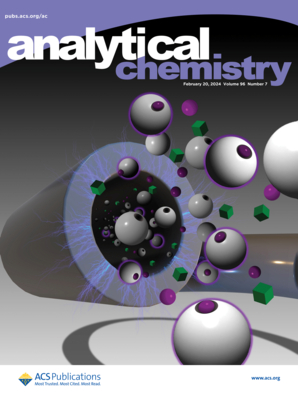Cellular and Intravital ATP Imaging Using a Merocyanine-Hybrided Rhodamine Fluorescent Probe.
IF 6.7
1区 化学
Q1 CHEMISTRY, ANALYTICAL
引用次数: 0
Abstract
The real-time intravital imaging of adenosine triphosphate (ATP) is essential for comprehending the intricate relationship between energy metabolism and cellular functions. To develop highly effective molecular tools for intravital ATP imaging, herein we designed a merocyanine-hybrided rhodamine fluorescent probe named PCR. The advantages offered by this probe toward ATP include near-infrared excitation/emission (λex/λem = 700/758 nm), a rapid (<3 min) and reversible response, an ideal dissociation constant (Kd = 7.05 mM), a relatively low detection limit (36.9 μM), deep tissue penetration (180 μm), and two-photon excitability. With the aid of the probe, we successfully detected both exogenous and endogenous ATP generation in viable cells. Furthermore, we monitored dynamic fluctuations in ATP levels under various metabolic perturbations and observed an augmented ATP production in cancer cells relative to normal cells. Subsequently, our investigation unveiled that β-lapachone, a well-established anticancer agent, induces cancer cell death by triggering reactive oxygen species-dependent energy crisis. Lastly, we visualized oscillations in ATP levels during cerebral ischemia/reperfusion by examining HT-22 cells and live mouse brain. The aforementioned successful application showcases the probe's potential for further elucidating ATP function in intricate biological environments, particularly in vivo.细胞和活体ATP成像使用的merocyanine - hybridrhodamine荧光探针。
三磷酸腺苷(ATP)的实时活体成像对于理解能量代谢与细胞功能之间的复杂关系至关重要。为了开发高效的活体ATP成像分子工具,我们设计了一种名为PCR的merocyanine- hybridrhodamine荧光探针。该探针对ATP具有近红外激发/发射(λex/λem = 700/758 nm)、快速(<3 min)可逆响应、理想解离常数(Kd = 7.05 mM)、相对较低的检出限(36.9 μM)、深度组织穿透(180 μM)和双光子兴奋性等优点。在探针的帮助下,我们成功地检测了活细胞中外源性和内源性ATP的产生。此外,我们监测了在各种代谢扰动下ATP水平的动态波动,并观察到相对于正常细胞,癌细胞中ATP的产生增加。随后,我们的研究揭示了β-lapachone是一种公认的抗癌药物,通过引发活性氧依赖的能量危机来诱导癌细胞死亡。最后,我们通过观察HT-22细胞和活鼠脑来观察脑缺血/再灌注时ATP水平的振荡。上述成功的应用展示了探针在复杂的生物环境中进一步阐明ATP功能的潜力,特别是在体内。
本文章由计算机程序翻译,如有差异,请以英文原文为准。
求助全文
约1分钟内获得全文
求助全文
来源期刊

Analytical Chemistry
化学-分析化学
CiteScore
12.10
自引率
12.20%
发文量
1949
审稿时长
1.4 months
期刊介绍:
Analytical Chemistry, a peer-reviewed research journal, focuses on disseminating new and original knowledge across all branches of analytical chemistry. Fundamental articles may explore general principles of chemical measurement science and need not directly address existing or potential analytical methodology. They can be entirely theoretical or report experimental results. Contributions may cover various phases of analytical operations, including sampling, bioanalysis, electrochemistry, mass spectrometry, microscale and nanoscale systems, environmental analysis, separations, spectroscopy, chemical reactions and selectivity, instrumentation, imaging, surface analysis, and data processing. Papers discussing known analytical methods should present a significant, original application of the method, a notable improvement, or results on an important analyte.
 求助内容:
求助内容: 应助结果提醒方式:
应助结果提醒方式:


